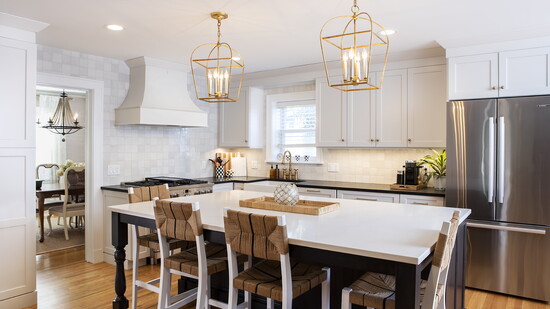Many homeowners overlook the transformative power of lighting when redesigning a room. Yet, a well-balanced layered lighting design can work wonders, turning a space from ordinary to extraordinary. Layers upon layers of lighting can breathe life into your design, fully illuminate your space, and infuse personal style into every room.
FLEXIBLE AND ADAPTABLE LIGHTING
While all lighting can enhance interior design, layered lighting that is adaptable and flexible is essential. Specific lighting sources can enhance ambiance, add visual interest and depth, or prioritize energy efficiency. Some lights can highlight points of interest, such as artwork, while others can perform a task or provide safety, such as lighting around a stairwell or in kitchen areas where we cook. This adaptability empowers us to make lighting choices that suit our needs and preferences.
AMBIENT LIGHTING
This is our overall illumination. It provides a uniform base layer for our rooms. The light brightens the entire space and makes it possible to see clearly. These lights are usually the ceiling fixtures, can lighting, pendants, chandeliers, and ceiling fans. Natural light is also considered in ambient lighting. Ambient lighting is crucial for any room but can often be bland. Another layer is needed to complement the foundational layer for a more personal style lighting solution, a concept where lighting reflects the homeowner's unique taste and preferences, adding a personal touch to the space.
TASK LIGHTING
Created for a specific purpose, task lighting highlights an area and removes the shadows and glares that might cause eye strain. Task lights may be placed in areas such as a stovetop or countertop in a kitchen. Task lights also might emphasize a workstation in an office. These lights are typically floor, table, desk, bathroom vanity, or cabinet lights. When choosing a task light, consider the light function of a particular room. An example would be a pendant light above a kitchen island, stovetop, or reading nook light.
ACCENT LIGHTING
Accent lighting is the third layer of lighting. This is where we can have fun with personal style. Accent lighting complements other features, highlights architectural elements, or provides beautiful decoration. It is a more subjective layer. Typical light sources are wall sconces, track lighting, LED tape lighting, or rope lighting. We can extend this lighting to emphasize featured items or illuminate hard-to-reach places.
Combining all three lighting sources—ambient, task, and accent lighting—can transform your room into a beautiful, safe, comfortable, and accessible space.
Visit our design gallery at roeserconstruction.com
